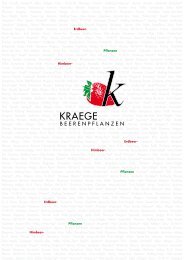Kraege_international_2019
You also want an ePaper? Increase the reach of your titles
YUMPU automatically turns print PDFs into web optimized ePapers that Google loves.
Raspberry<br />
Plants<br />
67<br />
Long Canes<br />
Raspberry Long Cane plants are, as<br />
the name indicates, long canes that<br />
are covered with buds. They are<br />
therefore suitable for harvesting in<br />
the year they are planted.<br />
Essentially there are two different<br />
Long Cane types: bare root and potted<br />
plants.<br />
The bare root Long Cane plants are<br />
shoots 1.60 – 2 m in length, which<br />
were taken from a raspberry propagation<br />
bed. Depending on the concentration<br />
of the material planted and<br />
the light conditions there, these canes<br />
have internodes of dif fering lengths<br />
and therefore dif ferent numbers of<br />
buds. The root growth should be as<br />
intensive as possible and have many<br />
fine root hairs.<br />
If you look at a raspberry field and<br />
see that roots have spread everywhere,<br />
even between the rows, it<br />
becomes clear that the root growth<br />
and thus also the water absorption<br />
will soon be the weak point of long<br />
cane cultivation with bare root plants.<br />
That is why potted plants have in -<br />
creasingly gained in importance.<br />
To produce this type of plant normally<br />
two potted green plants are<br />
planted in a container. These two<br />
green plants will be pulled up a trellis<br />
in the year when planted during<br />
the entire vegetation period. The aim<br />
is to have a container that has a good<br />
root system and two canes about 1.80<br />
m in length. As soon as the growth<br />
is completed and the plants are in<br />
their dormant period, they are placed<br />
in cold storage at minus 2° C.<br />
In the following year, the long cane<br />
plants are removed from cold storage<br />
and are placed or planted in a foil<br />
tunnel or under rain covers.<br />
Depending on the time the plants<br />
were placed, harvesting should occur<br />
65 to 80 days after planting. This<br />
type of nursing extends the pro -<br />
duction of raspberries. Pro duc tion<br />
before and after the harvest in the<br />
field is possible.<br />
Basically this kind of cultivation can<br />
be compared to that of strawberry<br />
Frigo plants.<br />
The main varieties for a fruit production<br />
with long cane plants are the<br />
summer raspberries Tulameen and<br />
Glen Ample.<br />
The standard method is to plant 6<br />
canes per metre. This means that<br />
there are 3 plants with 2 canes per<br />
metre.<br />
For this very intensive method of production,<br />
we often produce in foil tunnels<br />
or under rain covers. On the one<br />
hand, this helps short-rotation culture<br />
and, on the other, serves as rain shelter.
















